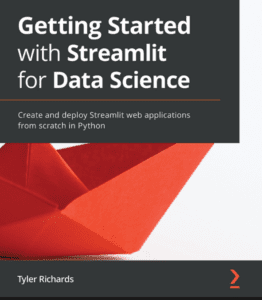Tyler Richards is the author of Getting Started with Streamlit for Data Science we got the chance to sit down with him and find out more about his experience of writing with Packt.
Q: What is/are your specialist tech area(s)?
Tyler : I’ve worked in data science for the past few years, and have spent a huge amount of my time creating data web applications for work, personal projects, and even job applications. It is always hard to say what my specialist tech areas actually are, but data web apps, communication, and integrity data science are probably three of them!
Q: How did you become an author for Packt? Tell us about your journey. What was your motivation for writing this book?
Tyler : I got very interested in a new library called Streamlit, which makes Python web apps a breeze, and started producing web apps and writing about the creation of the apps as well. At that point, Packt reached out to ask about a partnership between the two of us, and we figured a book would make a lot of sense for the community. I learned most of my data science skills by practically applying what I learned in books, and I tried to write the book that I would have wanted to read at the beginning of my data science journey.
Q: What kind of research did you do, and how long did you spend researching before beginning the book?
Tyler : I had been writing data apps for a couple years prior to writing the book, and had been using the Streamlit library intensely for a little under a year before I started on the book. Then, I spent ~3 months working on understanding the ins and outs of the library, and began to write after that!
Q: Did you face any challenges during the writing process? How did you overcome them?
Tyler : The hardest part was getting used to writing each and every day! I am not used to producing that much content regularly, and getting ramped up was a challenge. I listened to an interview with Jerry Sienfeld where he loosely said that if you sit down to write until you are done, you’re in for a world of hurt, and you should instead have a clear set time that you want to write and be done once that time is finished. I went by that, and made sure to do something fun after I finished writing for a longer period of time, as a reward for myself. It sounds incredibly childish, but it worked wonders.
Q: What’s your take on the technologies discussed in the book? Where do you see these technologies heading in the future?
Tyler : Streamlit is simply going to get easier and easier in the future. They’ll figure out deployment, figure out how to integrate super well within companies, and groups will either try and copy them or make their processes even easier. By the time they do this, Streamlit will have even more features and adoption, and catching up to their lead will be even more difficult.
Q: Why should readers choose this book over others already on the market? How would you differentiate your book from its competition?
Tyler : As of now, there are no other books that have Streamlit as the sole focus, the rest cover Streamlit lightly as one of many options. I truly believe that Streamlit is far better than the other options, and data scientists should dive deeply into it
Q. What are the key takeaways you want readers to come away from the book with?
Tyler : The key skill readers should come away with from the book is how to create their own Streamlit apps, and not just basic ones, but fully fledged data products that also happen to be beautiful. If you come out with that ability, I would define this as an extremely successful read!
Q. What advice would you give to readers learning tech? Do you have any top tips?
Tyler : I have written out my advice for aspiring data scientists here (https://insignificantdatascience.substack.com/p/advice-for-aspiring-data-scientists), let me know what you think!
Q. Do you have a blog that readers can follow?
Tyler : I write most on Twitter (https://twitter.com/tylerjrichards) but also have a personal website at (http://www.tylerjrichards.com/)!
Q. Can you share any blogs, websites and forums to help readers gain a holistic view of the tech they are learning?
Tyler : Streamlit has gorgeous documentation, I would check them out at (https://docs.streamlit.io/).
You can find Tyler’s book on Amazon by following this link: Please click here









